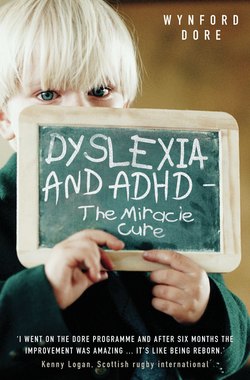Читать книгу Dyslexia and ADHD - The Miracle Cure - Wynford Dore - Страница 15
На сайте Литреса книга снята с продажи.
WHAT IS DYSLEXIA?
ОглавлениеDyslexia literally means ‘difficulty with reading’. It was originally used to describe the problems seen in neurological patients who had damage to the language areas of the thinking brain. Indeed, in the early twentieth century, many medical specialists believed that developmental dyslexia in children who developed reading difficulties without any evidence of brain damage was a functional problem within the very same area of the brain. Only recently, with the advent of brain scans, has doubt been cast on this theory.
In 1968, the World Federation of Neurologists (WFN) defined dyslexia as ‘a disorder in children who, despite conventional classroom experience, fail to attain the language skills of reading, writing and spelling commensurate with their intellectual abilities’.
In the eighties, the only definition of dyslexia was an exclusionary one. If a child’s difficulty with reading could not be explained by low intelligence, poor eyesight, bad hearing, inadequate educational opportunities or any other problem, then it was determined by exclusion that the child must be dyslexic. A more specific definition was needed rather than one based on exclusion.
The International Dyslexia Association (IDA) defines dyslexia as a neurologically based, often familial, disorder that interferes with the acquisition and processing of language. Varying in degrees of severity, it is manifested by difficulties in receptive and expressive language, including reading, writing, spelling, handwriting, and sometimes in arithmetic. Dyslexia is not the result of lack of motivation, sensory impairment, inadequate instructional or environmental opportunities, or other limiting conditions, but may occur together with these conditions.
The National Institute of Health (NIH) in the USA defines dyslexia as a specific learning disability that is neurological in origin. It is characterised by difficulties with accurate and/or fluent word recognition, and by poor spelling and decoding abilities. The NIH has spent many years researching learning disabilities. They have found that:
Dyslexia affects at least one out of every five children (20 per cent)
Dyslexia affects approximately the same number of boys as it does girls
Dyslexia is the leading cause of reading failure and school dropouts in the USA
Reading failure is the most commonly shared characteristic of juvenile offenders
Unless helped, children do not outgrow reading failure or dyslexia.
Key features of someone with dyslexia
He (or she):
Often has average or above-average IQ, but doesn’t do as well on school tests as they should
Feels ‘dumb’, has poor self-esteem and lacks confidence
Becomes easily frustrated and emotional about school, reading or testing, and often uses avoidance tactics to get out of doing these things
Seems to ‘zone out’ or daydream often, gets lost easily or loses track of time (attention deficit)
Reads or writes with additions, omissions, substitutions, repetition, reversals or transpositions of letters, numbers or words
Often confuses left/right, over/under
Has difficulty telling or managing time, being on time or learning sequenced information or tasks
Mispronounces long words; transposes phrases, words and syllables while speaking
Often has poor working memory so finds it difficult to work things out in their heads.
